The M20 scout car was based on the M8. But instead of a turret, was mounted a low, armored open-topped superstructure plus AA ring mount, with M2 heavy machine gun, the crew carrying a bazooka for good measure against bad encounters. The M20 was mostly a command vehicle fitted with additional radio equipment, used in forward reconnaissance or as impromptu armored personnel and cargo carrier as well. Some 3,680 M20s were built by Ford in this variants by 1943–1944, which was less than the 8500+ M8 Greyhounds, but still not anecdotal. The M20 was certainly not a rare sight on the Western Front in 1944 or Italy.


M8 Greyhound
The M20 was developed after the M8 itself, combining the qualities of a command car and personal/cargo carrier and it derived from one of the long path towards a standard US Army light armored car in WW2, a subject punctated by many prototypes, as shown in this US armoured car page detailing the competition and prototypes leading to the M8, also nickname the "grey ghost".
Indeed, when the M8 was first being developed, one requirement was that it would be adaptable for other uses and by late 1942, as the M8 was ordered and production at Ford was ramping up, a main variant started development, one of several vehicles, including and self propelled gun and an AA variant, all to provide an organic capability inside a reconnaissance platoon.
On 29 October 1942, an order was placed for a new armoured command cars which could be usable as armoured personal and cargo carrier as well. On 17 December 1942 an official recommendation from the Ordnance Committee approved the base design submitted by Ford, and on 31 December two projects were proposed under the respective designations of "Carrier, Personnel-Cargo, T20" and "Car, Command, Armoured, T26". Ford also proposed the "Carriage, Motor, Multiple Gun, T69" in the same swoop, as an organic AA defence vehicle. Still, months later, no M69 or M26 ever entered service.
The initial plan indeed called for very distinct vehicles, the T26 command vehicle keeping the turret but with the gun removed, extensive communications equipment installed in its place. There was to be probably a mock gun welded on the turret to look the part still. The T20 however being a pure transport vehicle, dispensed of the turret entirely, while raised sides were created around the now open fighting compartment. Inside this new space were installed six seats, and space was created where ammunition bins once existed, for jerrycans and supplies. Work started sooner at Ford on the T20, assuming it was the more complete conversion of the two, with a mockup produced in plywood over the original turret less vehicle, to test the practicity of the open compartment's design. It was soon realized a mount for a .50in machine gun could be still installed at the front, of the same model previously fitted on the turret, providing a good dual purpose defense.

As the mockup was demonstrated to the ordnance, discussions led to see how much the roles of the command car and the APC could be fused together. Indeed the common denominator of US procurement at the time, was always to keep the maintenance and supply as streamlined as possible by avoiding dispersion in countless models, unlike the Germans did. Even if a prototype was good, better standardization on the battlefield was alsways place front and center. Thus, since nothing opposed the installation of a powerful transmitter/receiver suite in the open compartment of the T20, Ford was ordered to with on a new "universal" design (the T69 was seen as a side project), and create the combined "Armored Utility Car, T26". Note the change in denomination.
This new prototype, this time made with real steel all round for trials, would become the basic design later reverted to T20 to avoid denomination confusion. The only change was a slightly higher sided open topped compartment, a the initial vehicle shown the seated troops still presented their heads to any sniper. The new vehicle was turned into precise plans, approved by the Ordnance dept. on 18 March 1943. The pilot T26 for production was completed in February 1943. it was sent to Aberdeen Proving Ground on 10 March, and completing its trials, all successful by 18 March 1943. Development was fast as Aberdeen skipped a whole set of trials previously made by the M8, seen as redundant as both the T26 and T8 were close. These tests at the Tank Destroyer Board of Aberdeen by March 1943 showing it was possible to access the sponson storage space from within and several radio sets were tested at Camp Hood by May 1943.
On 23 March 1943 Ford was contracted to produce 5,522 M20s, to be manufactured at their Chicago plant. On 1st April 1943, standardization was recommended, not as M26, but as "Armored Car, Armored, Utility, M10", later approved on 6 May. But on May, 16, it was changed to "M20" to avoid confusion with the M10 3in GMC (Wolverine) tank destroyer. Production at Chicago reached its peak (320 monthly by November 1943) but the end of the war (17 August 1945) saw the termination of the contract after 3,790 vehicles came out the production line.
The M20 kept the general layout of the M8, keeping the armoured driver's forward casemate and two louvred hatches over the engines, removable fenders down the sides of the forward and rear axles and six stowage bins either sides, that could be locked. The inter-space between axles could be also occupied by an external storage rack for mines or jerrycans, and receive a cover for protection. There were also hooks to strap any external haversack or payload.
The main redesign was the removal of the turret, including its panniers and ammo racks, replaced by an open fighting compartment protected by a low armoured shield all around. It was high enough to protect the heads of those inside when seated, but low enough for them to mount/dismount the vehicle. Trials were done even to see if it was possible to "cram" inside ten men, which was achieved once seats were dismounted (which could be done quickly in order to convert the vehicle as cargo carrier). In that case, the floor received an anti-slip pattern iron plating, pierced by attachment points for the removable seats and strapping points for the payload. The fact the storage bins were now accessible from inside was seen also as an handy feature as the crew could access ammunitions and a bazooka from within without dismounting the vehicle, avoiding any exposition.
In the end, the compartment was setup to carry seven men, six seated in the fighting compartment plus the driver. One of the six could also stand in a ring mount (see later). When all seats were removed, some 3,000lb of cargo could be packed inside the compartment, so that the vehicle would only have the driver making shuttles on the battlefield. The T26 originally had wooden benches on both sides of the compartment plus a left-rear radio set and full access to the driver’s compartment. Later this was changed for dismountable seats. When employed in command and control, the M20 received additional radio equipment fitted inside the open compartment. This emitter-receiver sets (type in research) provided longer range, to act as reconnaissance platoon main HQ communication center, reporting to the regiment.
Another item common to the M8 were the six M1 anti-tank mines stowed in the inter-axles space rack, later changed for jerrycan/utility racks. The 102 x 203 mm M1 Weighted 4.80 kg with 2.70 kg TNT and could work from 120 kg to 250 kg. It was strong enough to blast a wheeled vehicle's tyre and axle, or break a tank's track. It's tactical use was to create a safety perimeter around an M8/M20 observation position. It should be noted that the serial M8 carried also six Mk 2 fragmentation grenades, 6 MK 3 offensive grenades, four smoke grenades, and four M1 carbines, there replaced by M1 Garands.
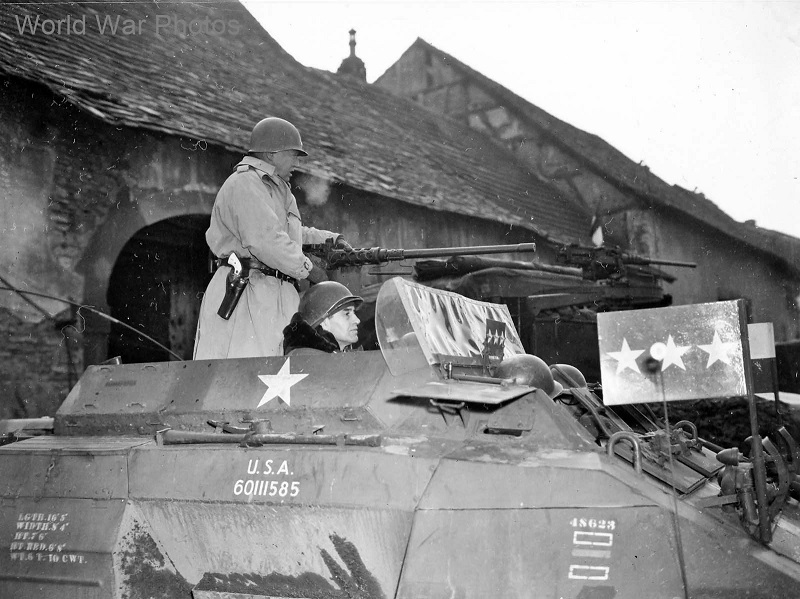
M20 Armored Car used by Gen. Patton src
In any case, the M20 APCs would bring infantry platoons additions to reconnaissance platoons featuring M8s, bringing firepower. These could stay supplied by M20s converted as cargos, and communicate with the command version to regimental or division level.
Tank destroyer battalions were the first to add to their self propelled tank destroyers some 30 M20s used as command and utility vehicles. Towed anti-tank guns Battalions had ten of these. Soon, eight tank destroyer battalions appeared in Italy by December 1943, featuring both the M8 and M20, but by July 1944 the 5th army was down to 185 M8s and 50 M20s. By 1945 it was reported that 111 M8s and 72 M20s were lost during the Italian campaign, mostly in the north by 1945, showing that the "fogotten front" was not a picnic.
The M20 also saw action from Normandy to north-western Europe including Germany. A few saw action in the Pacific (see later). Some 446 M20s were lost in Normandy, but the US Army still had by May 1945 some 1,445 of them in its inventory frontline. The M20 operated frequently with the M8 as it was originally designed to be part of reconnaissance platoons and batallions. Although lacking a 37 mm gun, it's 0.5in machine gun anyway was a trusted way to defend itself, the bazooka bringing some extra firepower while keeping the same mobility. As command vehicle, the two radios gave it more flexibility within the command structure. One of such vehicles was Patton's 3rd army personal vehicle in 1944.
All M8 had shorter range radios, and a M8 platoon could spread out in search of the anemy, communicating with the M80 command car, relaying these infos at the Batallion HQ. As "fast transport", mobility was reduced however. Effectiveness lesser in that role. But as it was tactically thought out, M8 platoons were supposed to foray ahead of a regiment, and individually if needed. If any of these unit was isolated, an M20 cargo could bring well needed supplies days in days out within enemy lines if needed.
The Free French the were only allies to received some 205 M20s, used in a similar way alongside their M8s. Interestingly enough, they saw action in Indochina until found not appropriate for the battlefield.
Post War, M20s remained in US service enough to see action alongside M8s in the Korean War. Indeed the army in 1946 planned a replacement called the M38 armored car, but ts protracted development eventually saw production faltering. M20s apparently never saw combat in Korea and were retired in 1952-53 from the US inventory, declared "surplus to standard".
wardrawings.be
warwheels.net
weaponsystems.net
On mvmec.org
militaryfactory.com
wwiivehicles.com
M8 wiki
scalemates.com
missing-lynx.com









Development of the M20 Command Car

M8 Greyhound
The M20 was developed after the M8 itself, combining the qualities of a command car and personal/cargo carrier and it derived from one of the long path towards a standard US Army light armored car in WW2, a subject punctated by many prototypes, as shown in this US armoured car page detailing the competition and prototypes leading to the M8, also nickname the "grey ghost".
Indeed, when the M8 was first being developed, one requirement was that it would be adaptable for other uses and by late 1942, as the M8 was ordered and production at Ford was ramping up, a main variant started development, one of several vehicles, including and self propelled gun and an AA variant, all to provide an organic capability inside a reconnaissance platoon.
On 29 October 1942, an order was placed for a new armoured command cars which could be usable as armoured personal and cargo carrier as well. On 17 December 1942 an official recommendation from the Ordnance Committee approved the base design submitted by Ford, and on 31 December two projects were proposed under the respective designations of "Carrier, Personnel-Cargo, T20" and "Car, Command, Armoured, T26". Ford also proposed the "Carriage, Motor, Multiple Gun, T69" in the same swoop, as an organic AA defence vehicle. Still, months later, no M69 or M26 ever entered service.
The initial plan indeed called for very distinct vehicles, the T26 command vehicle keeping the turret but with the gun removed, extensive communications equipment installed in its place. There was to be probably a mock gun welded on the turret to look the part still. The T20 however being a pure transport vehicle, dispensed of the turret entirely, while raised sides were created around the now open fighting compartment. Inside this new space were installed six seats, and space was created where ammunition bins once existed, for jerrycans and supplies. Work started sooner at Ford on the T20, assuming it was the more complete conversion of the two, with a mockup produced in plywood over the original turret less vehicle, to test the practicity of the open compartment's design. It was soon realized a mount for a .50in machine gun could be still installed at the front, of the same model previously fitted on the turret, providing a good dual purpose defense.

As the mockup was demonstrated to the ordnance, discussions led to see how much the roles of the command car and the APC could be fused together. Indeed the common denominator of US procurement at the time, was always to keep the maintenance and supply as streamlined as possible by avoiding dispersion in countless models, unlike the Germans did. Even if a prototype was good, better standardization on the battlefield was alsways place front and center. Thus, since nothing opposed the installation of a powerful transmitter/receiver suite in the open compartment of the T20, Ford was ordered to with on a new "universal" design (the T69 was seen as a side project), and create the combined "Armored Utility Car, T26". Note the change in denomination.
This new prototype, this time made with real steel all round for trials, would become the basic design later reverted to T20 to avoid denomination confusion. The only change was a slightly higher sided open topped compartment, a the initial vehicle shown the seated troops still presented their heads to any sniper. The new vehicle was turned into precise plans, approved by the Ordnance dept. on 18 March 1943. The pilot T26 for production was completed in February 1943. it was sent to Aberdeen Proving Ground on 10 March, and completing its trials, all successful by 18 March 1943. Development was fast as Aberdeen skipped a whole set of trials previously made by the M8, seen as redundant as both the T26 and T8 were close. These tests at the Tank Destroyer Board of Aberdeen by March 1943 showing it was possible to access the sponson storage space from within and several radio sets were tested at Camp Hood by May 1943.
On 23 March 1943 Ford was contracted to produce 5,522 M20s, to be manufactured at their Chicago plant. On 1st April 1943, standardization was recommended, not as M26, but as "Armored Car, Armored, Utility, M10", later approved on 6 May. But on May, 16, it was changed to "M20" to avoid confusion with the M10 3in GMC (Wolverine) tank destroyer. Production at Chicago reached its peak (320 monthly by November 1943) but the end of the war (17 August 1945) saw the termination of the contract after 3,790 vehicles came out the production line.
Design

The M20 kept the general layout of the M8, keeping the armoured driver's forward casemate and two louvred hatches over the engines, removable fenders down the sides of the forward and rear axles and six stowage bins either sides, that could be locked. The inter-space between axles could be also occupied by an external storage rack for mines or jerrycans, and receive a cover for protection. There were also hooks to strap any external haversack or payload.
The main redesign was the removal of the turret, including its panniers and ammo racks, replaced by an open fighting compartment protected by a low armoured shield all around. It was high enough to protect the heads of those inside when seated, but low enough for them to mount/dismount the vehicle. Trials were done even to see if it was possible to "cram" inside ten men, which was achieved once seats were dismounted (which could be done quickly in order to convert the vehicle as cargo carrier). In that case, the floor received an anti-slip pattern iron plating, pierced by attachment points for the removable seats and strapping points for the payload. The fact the storage bins were now accessible from inside was seen also as an handy feature as the crew could access ammunitions and a bazooka from within without dismounting the vehicle, avoiding any exposition.
In the end, the compartment was setup to carry seven men, six seated in the fighting compartment plus the driver. One of the six could also stand in a ring mount (see later). When all seats were removed, some 3,000lb of cargo could be packed inside the compartment, so that the vehicle would only have the driver making shuttles on the battlefield. The T26 originally had wooden benches on both sides of the compartment plus a left-rear radio set and full access to the driver’s compartment. Later this was changed for dismountable seats. When employed in command and control, the M20 received additional radio equipment fitted inside the open compartment. This emitter-receiver sets (type in research) provided longer range, to act as reconnaissance platoon main HQ communication center, reporting to the regiment.
Mobility
The M20 kept the chassis of the M8 Greyhound, featuruing a Hercules JXD engine providing speeds up to 90 kilometers per hour. The total weight of the M20 was about 6,800 kg while the total length was the same as the original Greyhound, 5 meters. It was well liked by its crews and proved quite reliable where it was used. Despite the absence of a turret, and some weight saving, performances were only marginally better. The M20 had a relatively silent engine, and kept some of the same stealthy caracteristic as the "grey ghost".Protection
The protection was the same as the original vehicle all around, while the raised sides over the open compartment offered some degree of protection against small arms fire and shrapnel, being 8 mm thicks and slightly sloped. However for overhead shrapnel, the crew fully was exposed. The opening was not however very large, and so the men could still crounch inside and see some sheltering. The only "protection" overhead was a simple waterproof standard tarpaulin, a welcome addition in winter and summer alike. No attempt to devise an improvized roof (nor authorized) was ever done or seen in photos.Armament
A M49 ring to carry a .50in calibre was mounted over the rear of the new compartment. This an anti-aircraft ring mount for the trusted M2 "ma deuce" heavy machine gun was not the only armament aboard apart the six men's personal M1 Garands and grenades. There was indeed a bazooka provided for the crew to compensate for its lack of anti-tank weaponry. It was recommended a wide variety of weapons and ammunitions in case the vehicle would be separated from its unit.Another item common to the M8 were the six M1 anti-tank mines stowed in the inter-axles space rack, later changed for jerrycan/utility racks. The 102 x 203 mm M1 Weighted 4.80 kg with 2.70 kg TNT and could work from 120 kg to 250 kg. It was strong enough to blast a wheeled vehicle's tyre and axle, or break a tank's track. It's tactical use was to create a safety perimeter around an M8/M20 observation position. It should be noted that the serial M8 carried also six Mk 2 fragmentation grenades, 6 MK 3 offensive grenades, four smoke grenades, and four M1 carbines, there replaced by M1 Garands.
Mods
The M20 underwent the same changes during production, just like the M8: Removal of the anti-personnel mine racks between the first and second set of wheels replaced by an extra storage box or jerrycan racks, addition of a storage box for the removable windscreens placed in front of the glacis.specifications | |
| Dimensions (L-w-H) | 197 x 100 x 90 inches |
| Total weight, battle ready | 12,250 lb |
| Crew | 4: Driver, Commander, MG-gunner, Radio |
| Propulsion | Ford 110hp Hercules JXD 6 cyl. engine |
| Top speed | 55 mph (90 kph) |
| Suspensions | 6x6 individual leaf spring |
| Range | 250 miles |
| Armament | .50in machine gun .30in machine gun |
| Armor | From 8-15 mm (0.31-0.59 in) |
The M20 Command Car in action

M20 Armored Car used by Gen. Patton src
In any case, the M20 APCs would bring infantry platoons additions to reconnaissance platoons featuring M8s, bringing firepower. These could stay supplied by M20s converted as cargos, and communicate with the command version to regimental or division level.
Tank destroyer battalions were the first to add to their self propelled tank destroyers some 30 M20s used as command and utility vehicles. Towed anti-tank guns Battalions had ten of these. Soon, eight tank destroyer battalions appeared in Italy by December 1943, featuring both the M8 and M20, but by July 1944 the 5th army was down to 185 M8s and 50 M20s. By 1945 it was reported that 111 M8s and 72 M20s were lost during the Italian campaign, mostly in the north by 1945, showing that the "fogotten front" was not a picnic.
The M20 also saw action from Normandy to north-western Europe including Germany. A few saw action in the Pacific (see later). Some 446 M20s were lost in Normandy, but the US Army still had by May 1945 some 1,445 of them in its inventory frontline. The M20 operated frequently with the M8 as it was originally designed to be part of reconnaissance platoons and batallions. Although lacking a 37 mm gun, it's 0.5in machine gun anyway was a trusted way to defend itself, the bazooka bringing some extra firepower while keeping the same mobility. As command vehicle, the two radios gave it more flexibility within the command structure. One of such vehicles was Patton's 3rd army personal vehicle in 1944.
All M8 had shorter range radios, and a M8 platoon could spread out in search of the anemy, communicating with the M80 command car, relaying these infos at the Batallion HQ. As "fast transport", mobility was reduced however. Effectiveness lesser in that role. But as it was tactically thought out, M8 platoons were supposed to foray ahead of a regiment, and individually if needed. If any of these unit was isolated, an M20 cargo could bring well needed supplies days in days out within enemy lines if needed.
The Free French the were only allies to received some 205 M20s, used in a similar way alongside their M8s. Interestingly enough, they saw action in Indochina until found not appropriate for the battlefield.
Post War, M20s remained in US service enough to see action alongside M8s in the Korean War. Indeed the army in 1946 planned a replacement called the M38 armored car, but ts protracted development eventually saw production faltering. M20s apparently never saw combat in Korea and were retired in 1952-53 from the US inventory, declared "surplus to standard".
Read More/Src
Books
Ford M8 and M20 - The US Army’s Standard Armoured Car of WWII, David Doyle.Links
historyofwar.orgwardrawings.be
warwheels.net
weaponsystems.net
On mvmec.org
militaryfactory.com
wwiivehicles.com
M8 wiki
scalemates.com
missing-lynx.com
Videos
Model Kits
Kits on scalemates, general query, full catalogue from 1:35 to 1.723D
on 3dwarehouse.sketchup.com







Gallery
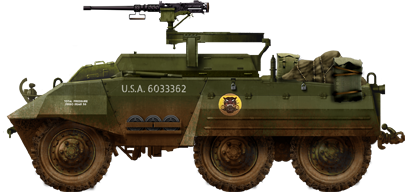
M20 of a Tank Hunter Bat. Italy December 1943
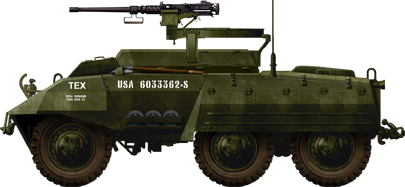
"Tex", 1st Platoon, Company C, 82nd Armored Reconnaissance Bttn, 2nd Armored Division - France, August 1944.
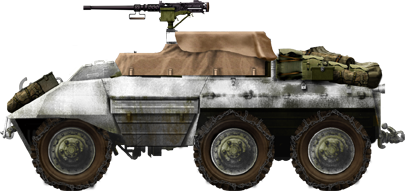
M20 in Winter 1944-45, Ardennes, Belgium. Note the roadwheels chains and closed tarpaulin to resist the cold.
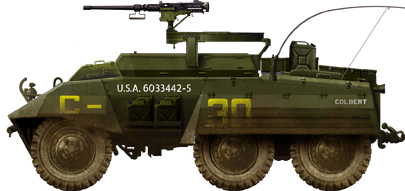
M20 "Colbert" Germany 1945
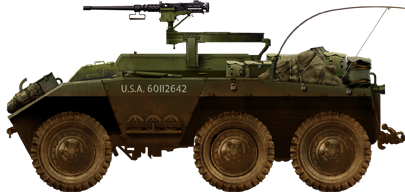
M20 Utility Armoured Car used as cargo carrier, Germany 1945
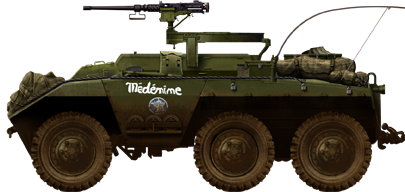
M20 FFL (Free French) "Medenine", Operation Dragoon, Rhone valley Sept. 1944, Southern France
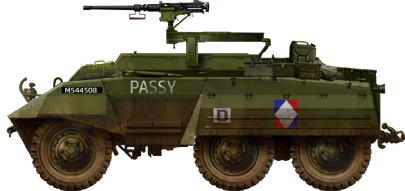
M20 FFL "Passy", Alsace 1945.
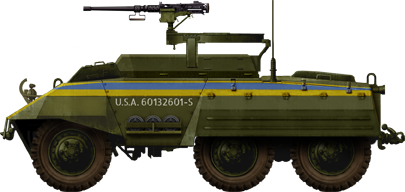
M20 of the Constabulary force in Berlin, 1959.


M20s vehicles in campaign, NW Europe 1944-45. Note the first was used as cargo and received an additional umprovized welded stowage bin on its back plate for extra stuff. On the seond photo, the large star roundel was impropvized to avoid confusion from the air. The danger was real as these vehicles were supposed to venture often beyond enemy lines.


"Rebel II", 7th Recce Rgt, part of the vanguard, Patton's 3rd Army, Ardennes 1945. Note the iconic "kilroy was here" and tarpaulin. A true WW2 meme, it seems to have been the mix of the popular British "Mr. chad" grafitti combined with the inspection mark by US shipyard inspector James J. Kilroy placed in spaces riveters could not access and erase. The concept became a favourite GI joke while on the move in 1944. It was found in nearly all buildings they slept along the way. Hitler enquired about the identity of this "Mr. kilroy" as found in recaptured house and vehicles. He even believed this was a popular top spy of the allies. Stalin did the same after seeing such inscription in the VIP bathroom.


Reconstitution (or preservation)? of General Patton's personal command M20, mix of early and late features with the windshield and old style stowage racks with anti-personal mines. Note also the divisional flags and large horns on the left. Patton was known to like coming "announced" to the front line.

Later production M20 without its side skirts

Unknown command vehicle (note the two antennae) in Germany, 1945

P001029 in Cherbourg on 27 juin 1944, 16h00 City Hall Maj. Gen. J. Lawton Collins

WW2 Tanks




























WW2 tanks posters

All Tiger tanks liveries.

Panther liveries and variants

WW2 Armour - All tanks











Tanks aces and single tanks series

Find more there

Museums, Movies, Books & Games
The Tanks and Armor in pop culture
Tanks and armored vehicles in general are only really grasped when seen first person: The mass, the scale, it's all there. Explore also the way tanks were covered in the movie industry, in books and in video games.Movies:
Best tanks movie on warhistoryonline.com
On imdb.com
On bestsimilar.com/
miltours.com
liveabout.com/
watchmojo.com
Video Games:
pcgamesn.com
historyhit.com
levvvel.com
vg247.com/best-tank-games
mmobomb.com/
alienwarearena.com

